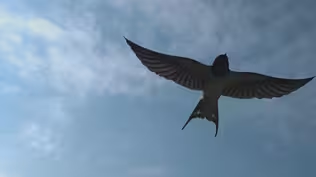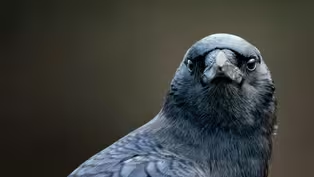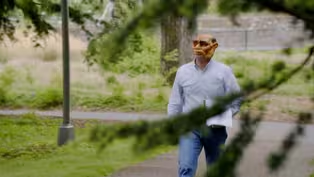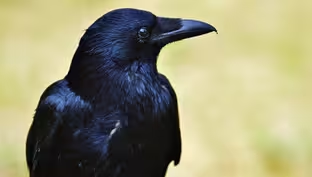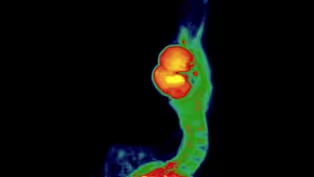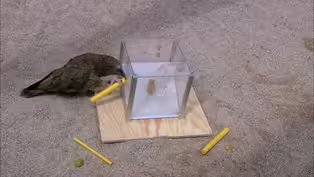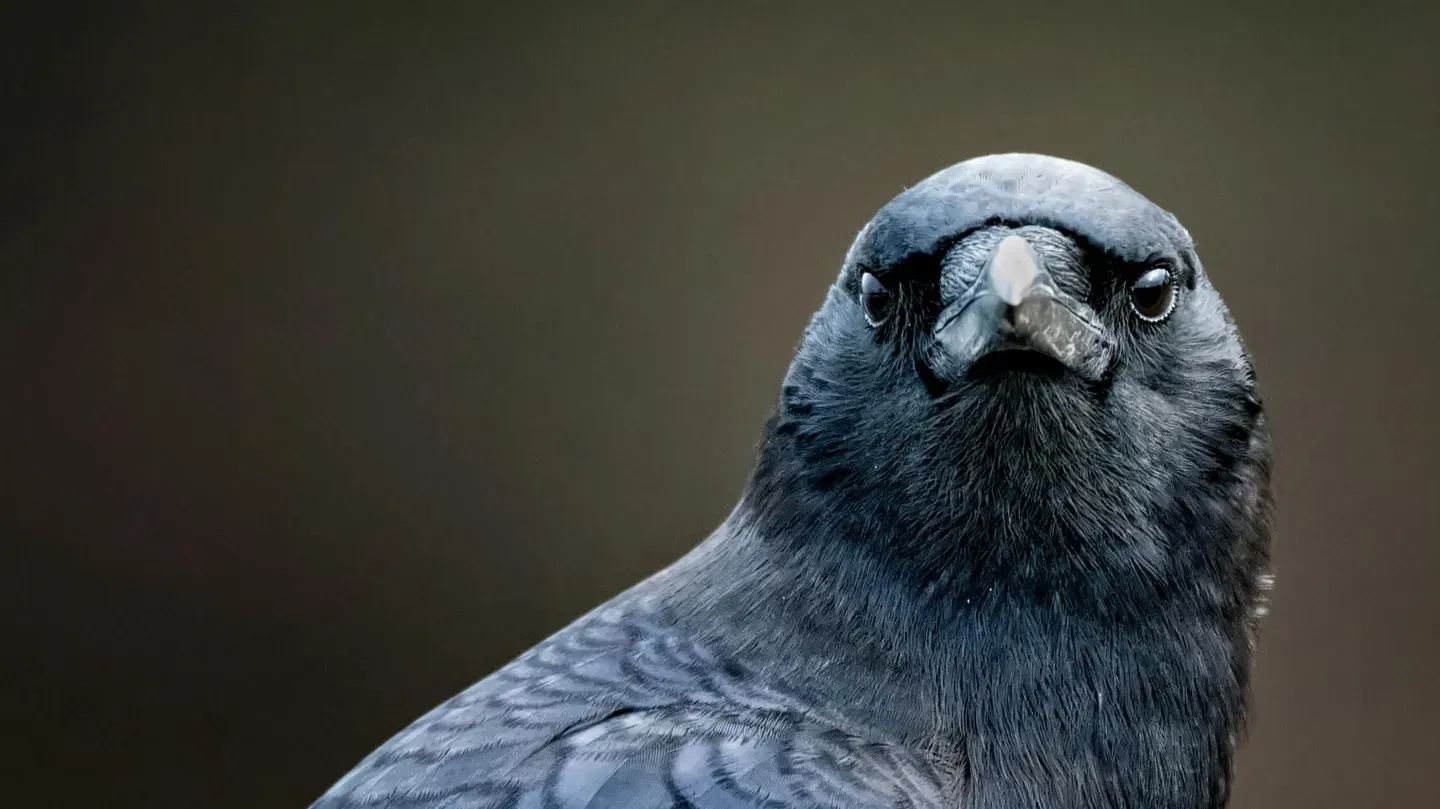

Bird Brain
Season 44 Episode 20 | 53m 32sVideo has Closed Captions
Watch as birds solve puzzles and challenge our basic notions of intelligence.
Watch astonishing tests of avian aptitude: parrots that can plan for the future, jackdaws that can “read” human faces, and crows that can solve multi-step puzzles with tools like pebbles, sticks, and hooks. Could these just be clever tricks, based on instinct or triggered by subtle cues from their human handlers?
Problems playing video? | Closed Captioning Feedback
Problems playing video? | Closed Captioning Feedback
National Corporate funding for NOVA is provided by Carlisle Companies. Major funding for NOVA is provided by the NOVA Science Trust, the Corporation for Public Broadcasting, and PBS viewers.

Bird Brain
Season 44 Episode 20 | 53m 32sVideo has Closed Captions
Watch astonishing tests of avian aptitude: parrots that can plan for the future, jackdaws that can “read” human faces, and crows that can solve multi-step puzzles with tools like pebbles, sticks, and hooks. Could these just be clever tricks, based on instinct or triggered by subtle cues from their human handlers?
Problems playing video? | Closed Captioning Feedback
How to Watch NOVA
NOVA is available to stream on pbs.org and the free PBS App, available on iPhone, Apple TV, Android TV, Android smartphones, Amazon Fire TV, Amazon Fire Tablet, Roku, Samsung Smart TV, and Vizio.
Buy Now

NOVA Labs
NOVA Labs is a free digital platform that engages teens and lifelong learners in games and interactives that foster authentic scientific exploration. Participants take part in real-world investigations by visualizing, analyzing, and playing with the same data that scientists use.Providing Support for PBS.org
Learn Moreabout PBS online sponsorship(screaming) ♪ ♪ NARRATOR: Birds, one of nature's most amazing success stories.
(chittering) There are thousands of different species, found everywhere on earth.
(trilling) They're beautiful... (screeching) inspiring... and mysterious.
♪ ♪ But could they be smart?
AUGUSTE VON BAYERN: People commonly think of birds as small-brained and not worth looking at.
But in the last couple of years, our view of bird minds has been revolutionized.
♪ ♪ NARRATOR: Scientists are putting birds to the test.
Can they solve problems?
Can they cooperate?
Are we friends again?
NARRATOR: Do they feel emotion?
(screeching) New research shows just how clever they can be.
Every day with these birds is interesting and different.
It's always fun and exciting and new.
NARRATOR: And perhaps they're more like us than we could have ever imagined.
CHRISTINA RIEHL: We're starting to realize that the simplest explanation may be that they're seeing the world in much the same way that we do.
(singing) NARRATOR: Exploring the "Bird Brain" right now on "NOVA."
♪ ♪ NARRATOR: It's picnic time at a small zoo in the English countryside, and visitors are about to meet a very special parrot.
MAN (on microphone): His name is Rio, and after three I want you to shout "Rio" as loud as you can.
One, two, three.
ALL: Rio!
NARRATOR: Rio is a ten-year old scarlet macaw from the South American rain forest who's been trained as an entertainer.
MAN: Can you show everybody your wings?
Come on then, Rio.
There we go.
(applause) NARRATOR: Rio will fly on cue.
Give him a big round of applause-- well, done, Rio, lovely flying today.
NARRATOR: And he's a talented gymnast.
MAN: Yeah, he's showing off today.
Really Rio, definitely.
♪ ♪ NARRATOR: But today he's going to try something that's not in his repertoire of show tricks.
It's called a string pull test.
Rio's favorite food-- a peanut-- is dangling on a string.
He'll have to pull the string up to get the peanut.
(squawks) Rio has not been trained to do this.
In fact, he's never seen this puzzle before.
And it isn't a skill a parrot normally needs.
If you're a parrot in the wild, you probably will never come across a treat dangling from a piece of string.
So it had to figure out what to do.
That implies these birds have the ability to visualize a puzzle... ♪ ♪ ...To visualize a physical action, and then to foresee the consequences of that action.
NARRATOR: Rio can see the string, and the peanut he wants.
At first, he's not interested.
♪ ♪ But after a few minutes--- and a little encouragement-- he figures out what to do.
♪ ♪ ♪ ♪ And once he's figured it out, he can repeat it without trial and error.
♪ ♪ JOHN MARZLUFF: When a bird pulls a string and secures food in that way, it demonstrates a level of insight into the problem.
It has worked out the mechanics and the process beforehand.
And that's not something we used to think birds really did much of.
♪ ♪ (chittering) NARRATOR: For many decades, scientists thought that most of a bird's behavior was ruled by instinct.
(birds squawking) ♪ ♪ In the 1930s, the Austrian zoologist Konrad Lorenz conducted some of the earliest studies on the lives of birds.
Working with geese, he saw that they learn from the moment they're born.
It's called imprinting-- they follow the actions of the first thing they see-- which is usually their mother.
But Lorenz showed that even this most basic instinctive behavior can be learned in a new way.
These geese imprinted on him.
RIEHL: The significance of the imprinting experiment was it showed that there were behaviors such as following that the behavior itself is instinctive.
But the cue, what do you follow, that's learned.
♪ ♪ NARRATOR: Lorenz spent years trying to tease out the difference between instinct and intelligent behavior.
In one set of observations, he discovered that a goose sitting on a nest reacts immediately if an egg rolls away, she brings it back to the clutch.
It looks like an intelligent action.
But if the egg is removed, she still continues the movement.
Her brain is responding instinctively to a simple trigger.
Even when the egg is replaced with a cube, she brings it back into the nest.
♪ ♪ RIEHL: When the bird continues the motion even after the egg is gone, that implies that the behavior is more or less instinctive.
The bird isn't consciously thinking through the consequences of its actions.
♪ ♪ NARRATOR: Even what looks like an incredibly complicated skill--- flying-- requires very little thought.
♪ ♪ MARZLUFF: There are many aspects of flying that are controlled without ever sending signals to the brain.
♪ ♪ And they're controlled right by feedback from the feathers to the spinal cord, and control how the wings are then moved to change flight, without thinking about it at all.
(chittering) NARRATOR: Huge groups of birds can fill the sky with beautiful and coordinated patterns of flight.
♪ ♪ This spectacle seems like it would require high levels of intelligence, but it's mainly instinctive.
♪ ♪ So is everything a bird does ruled by instinct?
Or do they have what we would consider intelligence?
♪ ♪ Meet Bran-- a hand-reared young raven-- and his owner, bird trainer Lloyd Buck.
Well, this is Bran, and he's a three-year-old raven.
We've had him since he was about ten days old, so he's what you call "complete social imprint" on humans, but he's particularly bonded with me.
We share a very, very close bond.
(squawks) ♪ ♪ NARRATOR: To keep Bran busy, Lloyd will sometimes give him a problem to solve.
(squawking) Here's one he tried a few months ago, in Bran's aviary, where there's a birdbath.
A piece of food is trapped inside a plastic bottle that's been crushed.
♪ ♪ First, Bran adds water.
That alone doesn't free the food, so he swishes it around so that liquid carries the food out of the bottle top.
♪ ♪ ♪ ♪ That's my boy!
Good boy!
NARRATOR: Lloyd didn't teach Bran how to solve this problem.
He just gave him the challenge and let him figure it out on his own.
(squawks) BUCK: So, we've presented him with that problem, and through his own intelligence and problem-solving abilities, he worked out to use his own water, what he had around him, to his advantage, which I think shows a lot of intelligence.
♪ ♪ NARRATOR: Ravens like Bran and parrots like Rio belong to two families of birds that are widely considered to be among the smartest species.
Ravens are part of the crow family.
Crows live almost everywhere on earth, with an average lifespan of ten to 15 years.
They have a starring role in many classic myths as cunning animals who bring bad luck.
(croaking) Parrots, on the other hand, have been loved as pets by humans for thousands of years.
They also thrive in many different environments, and they can live to be 80 years old.
♪ ♪ Their long life span gives them plenty of opportunity to learn new things, and that may be one reason why they seem so smart.
♪ ♪ At the Haidlhof Research Station near Vienna, scientists are studying the intelligence of many kinds of crows and parrots.
♪ ♪ (speaking German) (translated): What makes our center unique is the fact that we have multiple bird species here at the same time, and it is very interesting to compare them.
♪ ♪ NARRATOR: They're working with a type of parrot called a kea, from New Zealand.
This is John, and he'll be trying a much harder string-pull test.
First, peanut butter is hidden in a small tube and tied to the end of a string.
Right away this is a more complex challenge, because the treat is out of sight, instead of hanging right in front of him.
♪ ♪ To complicate things further, now there are two strings, but the second one just has a stick on the end.
John goes straight to the correct string where the reward hangs directly below him.
♪ ♪ Next, the two strings are crossed.
So now the reward is no longer directly below the attachment to the right string.
And John has to decide which string to pull.
♪ ♪ When the string is anchored here, and the reward is here, and a string is anchored here, and the reward is here, the position of the reward is actually opposite to where the bird might expect it to be.
So it implies an additional layer of processing.
NARRATOR: John immediately pulls the right string.
♪ ♪ Most of the kea parrots who try this puzzle need some practice, but even with the rewards and strings swapped around, they learn to pull the right one most of the time.
MARZLUFF: If they pull a string that is offset from the food, this really implies that they have a plan.
And that's a real key, they're able to plan this out mentally, work out the steps, and employ it correctly when they see the task.
♪ ♪ NARRATOR: Compared to other birds, parrots and crows have large brains in relation to their body size, and scientists believe that may be one reason why they can work out solutions to problems they don't encounter in the wild.
♪ ♪ Most bird brains are small.
But they have one critical area in common with humans and other animals with higher intelligence.
♪ ♪ MARZLUFF: The executive center of the bird's brain is right here.
And that's the part that really allows them to make plans and strategies and organize ideas to use to act upon things that will happen in the future.
(croaking) NARRATOR: Birds brains may be tiny, but for their size they seem to contain more brain cells-- or neurons-- than many other animals.
♪ ♪ MARZLUFF: The number of neurons is a better indication of brain power than the physical size of the brain.
And this is an interesting thing we've learned recently that bird brains actually pack a lot more neurons into a particular area than do mammal brains.
So even though they're physically very small in size, they have a lot of punch in that size.
♪ ♪ NARRATOR: The intelligence of parrots like kea is also thought to be influenced by where they come from.
In their natural habitat, the highest mountains of New Zealand, food is scarce.
Sometimes kea parrots can strip berries from shrubs and bushes.
Other times they have to search for insects.
♪ ♪ They only find enough to eat by being adaptable.
And that has an impact on their brains.
♪ ♪ MARZLUFF: Anything that involves innovation and trying new techniques and having to solve problems within the environment to get food, that all stimulates a greater connection of the neurons in one's brain.
♪ ♪ So they're basically building a strong brain by having to explore this complex and variable environment.
NARRATOR: Their explorations make kea parrots inquisitive-- and fearless.
And they're fascinating to watch.
♪ ♪ Because they evolved on New Zealand, where they had few predators, these birds don't seem afraid of anything.
(squawks) Until humans arrived, there was little to threaten them.
They could explore whatever they wanted-- and still do.
♪ ♪ This is very different from the other super-brains of the bird world.
Ravens and the rest of the crow family live alongside big predators.
(growling) (cawing) Like kea parrots, they must find food wherever they can-- even if they have to steal it.
But wolves and coyotes are dangerous, so crows and ravens have to be cautious.
MARZLUFF: Crows are famous for being afraid of new things that they encounter in their environment.
And most animals are.
It's a good strategy.
It keeps you out of trouble.
It pays to be wary.
But crows are famously wary.
(chirping) NARRATOR: Compared to parrots, ravens and the rest of the crows have a very different approach to solving problems.
♪ ♪ Auguste von Bayern works with New Caledonian crows, considered to be one of the most intelligent bird species.
♪ ♪ This is Wek.
She's wearing a collar because she recently lost her mate.
Come on.
NARRATOR: Crows mate for life, and Wek started pulling out her feathers when her partner died.
She's been raised by humans since infancy.
VON BAYERN: Wek was hand-raised and that's why she has a very close relationship with humans.
In all tests she's participated in she was one of the best birds and, yeah, she seems to be clever and enjoys to work in our experiments.
(cawing) ♪ ♪ NARRATOR: This experiment is designed to compare how New Caledonian crows and kea solve problems.
♪ ♪ Wek represents the crows, and for the kea parrots, this is Kermit.
Their reward: a peanut.
Their challenge is called a multi-access box.
VON BAYERN: As the name suggests, the bird is presented with a problem-- food in the center of a box, so out of reach.
And the special thing is that it can be accessed in four different ways.
So there are four different solutions to get the food out of that box.
♪ ♪ NARRATOR: The birds can pull the string to get the peanut out through the hole, drop a ball down a chute to dislodge it, prod the nut with a stick, or open the door and reach inside.
This is a new approach because usually animals are just tested with one problem and there's just one way of getting the food, and it's very interesting to see how species differ in the way they approach a problem and the way they explore that box.
NARRATOR: The first time both birds see the puzzle they make the same choice-- they just pull the string.
♪ ♪ ♪ ♪ Then the researchers take that solution away, to see what they'll do next.
Wek uses the stick to poke the nut free, but this isn't a surprise.
VON BAYERN: New Caledonian crows are very special because they're the only crow species that use tools in the wild.
♪ ♪ They obtain a lot of their diet by using tools.
♪ ♪ NARRATOR: Kea parrots don't use tools in the wild.
♪ ♪ But Kermit figures out a solution with the ball and chute.
♪ ♪ Again, the researchers remove the option that's been used-- ♪ ♪ for Wek, the hole for the stick is taped over.
Wek has to try something else-- ♪ ♪ so she tries the ball and chute.
With two choices left, Kermit just opens the door, reaches inside and takes the peanut.
♪ ♪ But Wek won't take this approach.
MARZLUFF: The last thing a crow wants to ever do is stick its head in something.
They're extremely vulnerable if they do that.
And to stick their head inside that box, it could trap them in it.
♪ ♪ NARRATOR: Wek still opens the door, but rather than put her head inside, she pokes the nut free with a stick.
♪ ♪ Kermit's last option is the stick.
His curved beak makes it very hard to hold, but he still sees this as a potential solution.
♪ ♪ Even though it's not easy.
♪ ♪ ♪ ♪ ♪ ♪ ♪ ♪ Both birds found four different solutions to the puzzle, showing they're able to think flexibly.
♪ ♪ MARZLUFF: The ability to think flexibly is certainly a hallmark of a cognitively advanced animal.
So rather than having this set response to a stimulus every time, as Lorenz worked upon, now you've got a whole battery of responses that could be put into play.
And now it's a mental task to sort among which ones are best for a given situation.
♪ ♪ NARRATOR: A bird's environment can encourage flexible thinking.
Like humans, birds seem to learn new things by playing.
♪ ♪ (speaking German) (translated): The great thing about keas is that they are very playful and curious.
They are not only interested in new things, but are also quite daring.
They have a notorious urge to explore everything they see and they want to play and explore the physical effects and consequences of their actions.
♪ ♪ NARRATOR: Researchers noticed that kea parrots often try to put one object inside another.
♪ ♪ So they give them a related challenge-- a selection of tubes fixed to the floor.
The younger birds are fascinated, trying to put the toys into the tubes.
There's no food reward, just curiosity.
And they seem to get better at learning which toys fit which tubes.
♪ ♪ Can they take this new knowledge and apply it in a different situation?
♪ ♪ A peanut stuck in a tube is a new problem to solve.
♪ ♪ The younger birds approach it first.
♪ ♪ ♪ ♪ This one studies the problem from all angles.
♪ ♪ ♪ ♪ She picks up a block, but seems to know that it's too big.
♪ ♪ She then selects the one block that fits the tube.
♪ ♪ Only the birds that played with the tubes and toys can solve this on their own.
RIEHL: The ability to learn skills in one context, then transfer them to another context, is another thing that allows researchers to infer that this is a conscious process going on.
That these are not just instinctive behaviors, that they're learning new things, and that they're able to transfer this knowledge.
♪ ♪ NARRATOR: This is a similar challenge.
The reward is in plain sight, but the tube is too long, and the food can't be reached.
The catch can be released by dropping a stone onto it.
to do that, Wek is going to have to figure out how the catch works.
The researchers replace the long tube with a shorter one.
Now Wek can reach the catch, and she quickly learns how to open it with her beak.
When the crow experiences the short tube, they can release the food through their normal process, peck on something.
That's what crows typically do, is bite or peck or probe with their beaks.
So they learn the relationship-- to get food, that lever needs to be tripped.
NARRATOR: But once she's learned how the catch works, can she figure out how to release it when she can't use her beak?
♪ ♪ Wek realizes that she can release the catch by dropping the stone on it.
And using a stone to get food in this way is not something a crow would normally do in the wild.
RIEHL: The fact that the crow is able to take a stone and move the same object that that bird had previously moved with its bill, implies that the crow is thinking ahead and visualizing the action that dropping the stone will result in the same movement that its bill did.
♪ ♪ NARRATOR: Using an unfamiliar tool to get food is a demanding mental task, even for New Caledonian crows.
♪ ♪ At the Max Planck Institute in Germany, the researcher sets up a puzzle to see if a crow can understand how to get a reward by pulling on a hook.
♪ ♪ Two hooks are covered by a plastic sheet.
Only one of them contains a small white container with food.
♪ ♪ ♪ ♪ ♪ ♪ This crow seems to get it right away.
But was it a lucky guess?
Or was she using knowledge that comes from her natural environment?
New Caledonian crows are the only species of bird that's been observed to use hook tools in the wild.
♪ ♪ They use the stems of pandanus plants to make kind of like jigsaw-bladed fish hook sorts of tools.
They'll shove that down a hole and a grub will either grab onto it, or they'll actually skewer the grub.
They make hooks that turn to the left or to the right.
They use them appropriately.
♪ ♪ RIEHL: What's interesting here is that it seems like they are able to bring this skill that they use in the wild normally into a lab setting that's completely unlike the environment that they normally use it in.
To a hook that isn't one that they've made themselves, that in fact looks nothing like the hooks they make themselves.
But is still hook-shaped.
And they clearly understand the repercussions of that hook shape.
(chirping) NARRATOR: Crows are not only good at solving problems, they're also good at negotiating complex sets of relationships, because they live in large groups.
Many scientists believe that forming social relationships within big groups helps drive the intelligence of animals like chimps and dolphins.
(clicking) Can this also be true for birds?
RIEHL: Living in a social group is hard.
You have to remember alliances.
You have to remember friendships.
And so there's a hypothesis, the social intelligence hypothesis, that proposes that the selective pressures of living in these groups, of having to meet all these challenges, has favored the evolution of a brain that can do more complex cognitive processing.
♪ ♪ NARRATOR: But what happens in birds' social groups?
Do they learn from each other?
♪ ♪ Valerie Dufour used to study great apes.
Now she applies some of the same methods to studying rooks, who are members of the crow family.
♪ ♪ She watches how they interact with each other and analyzes the results.
♪ ♪ Valerie found a social network as complex as those seen in groups of monkeys and other primates, with a clear structure and close friendships.
But how does this social structure relate to intelligence?
Valerie puts a group of rooks to a test she's used with primates.
This box is... a little set up that's created to see whether birds can learn from watching each other, okay?
So there's two ways to open that box.
You can either pull on the little rope there.
And in that case, just lift the ball and they can pick up the reward that's in there.
Or, you can just simply push on that box and in that case, you just need to put the beak through and pick up the reward.
♪ ♪ NARRATOR: One bird is trained to pull the ball, and half the rooks are allowed to watch.
(cawing) When this group tries the puzzle, they all do the same thing, and pull the ball.
♪ ♪ Meanwhile, the other half are watching a bird trained to use the other solution-- to push the ball.
And when these birds try the puzzle, they repeat what they saw-- they push the ball.
This suggests these rooks learned how to solve the puzzle by watching another bird.
This is called social learning, and it's considered very high-level thinking.
MARZLUFF: It's certainly more advanced than an imprinted behavior.
It's also much more advanced than a behavior that you learn by individual trial and error.
In this case, you're having to watch others perform a behavior, and then replicate that.
♪ ♪ DUFOUR: It's new and it's exciting because it's something we've known in other species like in primates, for example.
Nobody would have guessed about the rooks or the crows or the ravens.
Nobody would have been able to say, "Yes, I expect them to be able to do that"; we had no idea.
Social learning in crows and parrots could be a result of their larger brains.
(cawing) But what about birds with smaller brains-- like geese?
♪ ♪ In the same place that Konrad Lorenz studied his geese, Isabella Schieber of the University of Vienna is exploring whether there's more to the goose mind than basic instinct.
♪ ♪ Geese live in a clear social hierarchy.
♪ ♪ And this experiment tests whether their natural pecking order helps them figure out other relationships.
(honking) Isabella arranges seven cards in a row and assigns a value to each one-- blue being the highest, and black the lowest.
The geese don't see the complete row, they only see one pair at a time.
In the experiment, green is higher than yellow, so under the green card is a treat ♪ ♪ and the goose learns this pair.
♪ ♪ But yellow is higher than purple, so on the next round, the reward is under the yellow card.
♪ ♪ Now he's been taught that green is higher than yellow, and that yellow, in turn, is higher than purple.
Next, purple is higher than red-- so now purple has the treat, and so on down the row.
♪ ♪ Once the geese have learned the relative value of all the cards, the next stage is to see if they can apply this knowledge to a harder challenge.
♪ ♪ They're shown an entirely new set of pairs, with no food rewards.
♪ ♪ Over and over, the geese choose the higher value card, even though they never saw the entire row all at one time.
♪ ♪ RIEHL: The ability to rank objects in a hierarchy is, it's a form of reasoning called inference, transitive inference.
And it was formerly thought that only apes and very sophisticated animals could do this.
MARZLUFF: So knowing that card A is greater than card B, and that card B is greater than card C, you might be able to infer A is greater than C. Well, and these birds obviously did that.
NARRATOR: It's clear that geese, despite their small brains, understand hierarchies.
And in their social groups, they also seem to cooperate.
♪ ♪ When they fly in formation, they appear to work together, whether it's intentional or not.
When geese fly in formation, they gain aerodynamic benefits, by riding the vortex of air off of each other's wingtips.
There's a bit of extra lift there that they gain.
♪ ♪ So they do switch positions as they're flying, and get some assist from the other individuals.
♪ ♪ NARRATOR: So can birds actually cooperate to solve problems?
♪ ♪ Like geese, kea parrots live in social groups with complex relationships.
♪ ♪ This experiment tests whether they can work together as a group.
No one bird can lift the lid off the food box by itself.
♪ ♪ But if one bird sits on the other end of the see-saw, the lid rises and the rest get to feed.
♪ ♪ After a while, this kea parrot hops off the seat, and another takes its place.
♪ ♪ ♪ ♪ ♪ ♪ Eventually, each bird gets to eat.
♪ ♪ MARZLUFF: That's a clear demonstration of cooperation, where some individuals are up there opening the lid, and others are feeding.
And then they switch off.
I think it shows they're all working to the same goal.
They get to eat.
They're using the social group to attain their individual goals here.
♪ ♪ NARRATOR: This feat of cooperation suggests that these birds may be communicating with each other in some way.
(cawing) But can a bird communicate with a human?
(cawing) Jackdaws are members of the crow family with a pair of very unusual eyes.
♪ ♪ VON BAYERN: Jackdaw eyes are quite conspicuous.
They are light on the outside and dark in the middle, so they are rather similar to our own eyes.
So we were interested in testing how responsive jackdaws were to communicative eye signals.
This test was designed for a jackdaw named Dhuli.
(Auguste imitating Dhuli's caw) Food is hidden under one of two cups.
Then Auguste gives Dhuli a very subtle clue-- she just looks at the correct cup.
Dhuli has to read Auguste's eye movements in order to choose the right cup.
The gaze experiments are interesting on several dimensions.
One, they show that a bird is very attentive to the gaze of another animal, another species.
In this case, that it's bonded with the human.
NARRATOR: Dhuli understands that Auguste's eye signals are directing her to the cup with food under it.
She's able to grasp this form of communication.
But she also seems to be demonstrating another cognitive ability.
She appears to know there's food under the cup even though she can't see it.
This is called object permanency.
MARZLUFF: Object permanency is a concept that humans develop when they're three or four years old.
They can understand that a hidden object is still there.
And so for birds to be able to demonstrate this has been profound, and, again, suggests to us that these birds have those abilities that a young human would too.
NARRATOR: But some tests are really hard-- even for young humans.
Like this one involving chocolates.
These children are given one chocolate and their mothers explain that they can either eat that chocolate now, or not eat it, wait for five minutes and be rewarded with two chocolates.
♪ ♪ Understanding a trade-off and planning for the future is a kind of reasoning that doesn't develop in children until they're three or four years old.
So it's very hard for them to wait.
For those that try to wait, five minutes is a long time with a chocolate right in front of them.
♪ ♪ They try ignoring it.
Or distracting themselves.
♪ ♪ ♪ ♪ Or even bending the rules.
♪ ♪ ♪ ♪ ♪ ♪ (whispering): Don't eat the chocolate.
NARRATOR: At last, the time is up, and here's their reward: two chocolates.
♪ ♪ I-- watch what I can do.
NARRATOR: Being able to delay gratification-- trade something now for something better in the future-- is a key developmental milestone in children.
♪ ♪ But can a raven do something similar?
♪ ♪ This is Rumo.
He likes bread, but he prefers cheese.
♪ ♪ Can he learn to wait for the treat he likes better?
♪ ♪ It's called a delayed exchange test.
♪ ♪ DUFOUR: The exchange is a little bit complicated because it involves two main difficulties.
First, you have something in your possession, so you possess something.
It might be valuable, so obviously you want to keep it.
And you have to accept to lose it to get something better in return, and you have to wait a little bit.
And that's very difficult.
♪ ♪ NARRATOR: First, Rumo is taught that he can trade his bread for some cheese.
But then, he has to wait.
♪ ♪ Sometimes Rumo drops the bread, perhaps as a way to make waiting easier.
♪ ♪ And the more Rumo likes a particular food, the longer he will wait.
♪ ♪ Sometimes he'll go for several minutes before he exchanges bread for cheese.
♪ ♪ But if the food on offer is one he doesn't like-- like a grape-- he won't wait.
He just eats the bread.
Mastering a delayed exchange had been documented in chimps, but never before in crows.
MARZLUFF: The ability of these animals to wait up to five or six minutes implies a couple of things.
One, they're making a tradeoff, a very sophisticated calculation.
"I'm going to get something better if I wait this amount of time."
And that's a difficult mental process.
It clearly shows they're planning ahead, because they're calculating that tradeoff.
♪ ♪ NARRATOR: Another way many birds plan ahead is that when they have more food than they can eat, they hide it and return to it later.
Rumo does the same-- as do most crows.
RIEHL: Many crows and many jays-- which are also members of the crow family-- hide food.
And they come back to it later.
It's called caching.
And it's a really complicated behavior, and it's really challenging, because they have to remember the locations of dozens or hundreds of spots where they've hidden food.
And they might even have to remember things like whether another individual was watching them when they hid it, and whether another individual might steal it.
♪ ♪ NARRATOR: Ravens will also hide things that they can't eat-- like toys.
♪ ♪ So can they learn if a person watching them is likely to steal their treasure?
♪ ♪ Two researchers watch the ravens hide their toys.
♪ ♪ And the ravens know they're being watched.
♪ ♪ One of the researchers goes into the aviary, in full view of the raven.
She approaches the hiding place.
♪ ♪ She looks at the toy, but leaves it where it is.
♪ ♪ The second researcher goes into the aviary, ♪ ♪ but she is a thief.
♪ ♪ ♪ ♪ (cawing) ♪ ♪ The next time the ravens are given food, they're watched by the honest researcher, and they hide the food in plain view.
♪ ♪ But when the thief watches them, the ravens hide their food in a part of the aviary out of her sight.
MARZLUFF: I think, in their brain, they are learning the association between one individual and a benign task, let's say, they don't bother the cache.
They don't take it.
And with another individual, they're learning that this is a dangerous individual.
It takes things of mine.
♪ ♪ NARRATOR: John Marzluff has done his own experiments to see if crows can recognize the face of a person who's a threat.
He and his team at the University of Washington went undercover to test the birds' reactions to being caught and tagged.
When we first captured birds we were wearing this mask.
So the birds that were immobile under a net saw this person coming to them, grabbing them, stretching out their wings to measure them, applying rings to their legs to identify them, and then letting them go.
NARRATOR: Crows don't like being caught, even when they're unharmed.
So the question was would they remember that the masked man was a threat?
♪ ♪ A few days after the initial tagging, Marzluff walked across the campus again.
He kept the mask on, but he left the crows alone, to see if he'd get any response.
(cawing) ♪ ♪ MARZLUFF: It was very striking.
The first time after we did this experiment, and we walked with the caveman mask, the birds immediately responded to that.
(cawing) They scolded with harsh calls that are indicative of a predator.
(cawing) And they gathered around us.
They attracted others in.
And they would even dive down at us.
(cawing) Marzluff discovered that the crows were somehow telling each other that the person in the caveman mask was dangerous.
(cawing) And what's more amazing, even though the team never again caught crows with the mask on, that reaction has been passed down through several generations.
It's been 11 years since we caught seven birds on our campus with this mask.
And nearly half of all the birds we encounter on a given day respond strongly to that face.
(cawing) Even though they weren't even born at the time we first did our capture.
The only experience they have with that caveman is hearsay.
♪ ♪ Now, Marzluff is studying another remarkable behavior.
It's called a crow funeral.
His team puts a decoy that looks like a dead crow on the sidewalk, (cawing) and within just a few minutes, the trees are filled with screeching crows.
(cawing) Marzluff showed the crows a similar decoy in the lab and brain scans reveal that they're activating their memory centers.
♪ ♪ But are these memories also linked to emotion?
(cawing) MARZLUFF: I think birds do feel emotion.
Maybe not exactly like we do.
(cawing) But they've got the parts of the brain that cause us to feel calm or anxious or fearful.
And those feelings in us are motivated by chemicals that are released in the brain.
And birds have those same chemicals.
♪ ♪ So I think it would be unusual if they don't.
NARRATOR: Emotion in birds is being studied by scientists around the world.
In one example, researchers noticed that a distressed raven appears to be comforted by a close friend.
(cawing) This raises the possibility that ravens might understand what other ravens are feeling.
This is called theory of mind, and it might be the next frontier in understanding how birds think.
(cawing) RIEHL: Theory of mind is the hypothesis that animals are capable of mentally putting themselves in the perspective of other animals.
Humans can do this.
We empathize with each other.
And so the question is: can birds do this?
Do birds have theory of mind?
♪ ♪ It's hard to know whether birds feel emotions in the same way that people do, because we can't ask them how they're feeling.
But we know that birds get upset.
We know that they're happy.
And so the simplest explanation is that their emotions are probably quite similar to ours.
♪ ♪ NARRATOR: Lloyd Buck would agree with that.
When Lloyd's been away for a few days, Bran is excited to see him back.
Then he gets angry with Lloyd.
Yes, you're cross, aren't you, because I left you?
I left you, eh?
You haven't seen me for two days, have you?
You haven't seen me for two days and you're angry.
♪ ♪ NARRATOR: But eventually Bran takes hold of Lloyd's finger and won't let go.
We've made up now, we're friends again, eh?
We're friends again.
NARRATOR: This can sometimes go on for an hour before Bran lets go.
You've been a good boy.
NARRATOR: Finally, Lloyd is forgiven.
♪ ♪ Calming down now, yeah?
Yes?
♪ ♪ Scientists once believed that birds were driven by pure instinct.
Now it's clear that at least some species are not only intelligent, but may be emotional too.
Just how much their minds resemble our own is the next question to explore.
RIEHL: You can explain a lot of animals' actions through instinctive behaviors that don't require a lot of conscious thinking.
But now it's become harder and harder to ignore the evidence that birds are capable of solving problems, of making friendships, of learning, of putting themselves into the experiences of other animals.
♪ ♪ And I think we're starting to realize that the simplest explanation may not be that they're automatons.
The simplest explanation may be that they're seeing the world in much the same way that we do.
♪ ♪ ♪ ♪ To order this program on DVD, visit ShopPBS or call 1-800-PLAY-PBS.
Episodes of "NOVA" are available with Passport.
"NOVA" is also available on Amazon Prime Video.
♪ ♪
Video has Closed Captions
Preview: S44 Ep20 | 30s | Watch as birds solve puzzles and challenge our basic notions of intelligence. (30s)
Video has Closed Captions
Clip: S44 Ep20 | 1m 57s | Crows remembered the face of a person they considered a threat—even across generations. (1m 57s)
Clip: S44 Ep20 | 1m 49s | Crows can remember the face of their captors—even after generations. (1m 49s)
The Surprising Power of a Bird Brain
Video has Closed Captions
Clip: S44 Ep20 | 1m 4s | Bird brains may be tiny, but they pack in as many—or more—neurons as much larger animals. (1m 4s)
These Birds Are Smarter Than You Think
Video has Closed Captions
Clip: S44 Ep20 | 3m 9s | Can these birds solve the puzzle and claim their prize? (3m 9s)
Providing Support for PBS.org
Learn Moreabout PBS online sponsorshipSupport for PBS provided by:
National Corporate funding for NOVA is provided by Carlisle Companies. Major funding for NOVA is provided by the NOVA Science Trust, the Corporation for Public Broadcasting, and PBS viewers.

